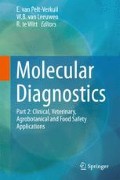Abstract
Next Generation Sequencing (NGS) is a huge technological advance in the molecular typing of micro-organisms. This chapter describes the use of NGS in food-borne outbreak investigation, source attribution and also describes the first steps in using Whole Genome Sequencing (WGS) data in molecular risk assessment. The rapidly decreasing costs and operational time make that WGS will likely replace currently used molecular typing methods, such as MLST, MLVA and PFGE, in outbreak investigation and source attribution in the near future. Because of the superior level of resolution and because all genetic information (including virulence and antimicrobial resistance genes) of the organisms can be revealed, WGS can be considered as the ultimate “all-in-one” typing method.
Access this chapter
Tax calculation will be finalised at checkout
Purchases are for personal use only
References
Aarestrup FM, et al. Integrating Genome‐based Informatics to Modernize Global Disease Monitoring, Information Sharing, and Response. EID. 2012;18(11).
Drummond AJ, et al. Bayesian phylogenetics with BEAUti and the BEAST 1.7. Mol Biol Evol. 2012;29:1969–73.
EFSA. Scientific Opinion on the evaluation of molecular typing methods for major food-borne microbiological hazards and their use for attribution modelling, outbreak investigation and scanning surveillance: Part 1 (evaluation of methods and applications. EFSA J. 2013;11:3502.
Franz E, et al. Genetic features differentiating bovine, food, and human isolates of Shiga toxin-producing Escherichia coli O157 in The Netherlands. J Clin Microbiol. 2012;50(3):772–80.
Foxman B, et al. Choosing an appropriate bacterial typing technique for epidemiologic studies. Epidemiol Perspect & Innov. 2005;2:10.
Jolley KA, Maiden MCJ. BIGSdb: scalable analysis of bacterial genome variation at the population level. BMC Bioinform. 2010;11:595–606.
Karmali MA, et al. Association of genomic O island 122 of Escherichia coli EDL 933 with verocytotoxin-producing Escherichia coli seropathotypes that are Linked to epidemic and/or serious disease. J Clin Microbiol. 2003;41(11):4930–40.
Pérez‐Losada M, et al. Pathogen typing in the genomics era: MLST and the future of molecular epidemiology. Infect Genet Evol. 2013;3. http://dx.doi.org/10.1016/j.meegid.2013.01.009.4.
Pielaat A, et al. First step in using molecular data for microbial food safety risk assessment; hazard identification of Escherichia coli O157:H7 by coupling genomic data with in vitro adherence to human epithelial cells. Int J Food Microbiol. 2015. http://dx.doi.org/10.1016/j.ijfoodmicro.2015.04.009.
Sabat AJ, et al. Overview of molecular typing methods for outbreak detection and epidemiological surveillance (Review). Eurosurveillance. 2013;18(4).
Schmid D. Whole genome sequencing as a tool to investigate a cluster of seven cases of listeriosis in Austria and Germany, 2011–2013. Clin Microbiol Infect. 2014;20:431–6.
Recommended Literature
Laing C, Buchanan C, Taboada EN, Zhang Y, Kropinski A, Villegas A, Thomas JE, Gannon VPJ. Pan-genome sequence analysis using Panseq: an online tool for the rapid analysis of core and accessory genomic regions. BMC Bioinform. 2010;11.
Stasiewicz MJ, et al. Genomics tools in microbial food safety. Curr Opin Food Sci. 2015;4:105–10.
Strachan NJC, Rotariu O, Lopes B, Macrae M, Fairley S, Laing C, Gannon V, Allison LJ, Hanson MF, Dallman T, et al. Whole genome sequencing demonstrates that geographic variation of Escherichia coli O157 genotypes dominates host association. Sci Rep. 2015;5.
Struelens MJ, Brisse S. From molecular to genomic epidemiology: transforming surveillance and control of infectious diseases. Eurosurveillance. 2013;18(4).
Underwood AP, et al. Public health value of next-generation DNA sequencing of enterohemorrhagic Escherichia coli isolates from an outbreak. J Clin Microbiol. 2013;51:232–7.
Author information
Authors and Affiliations
Corresponding author
Editor information
Editors and Affiliations
Rights and permissions
Copyright information
© 2017 Springer Nature Singapore Pte Ltd.
About this chapter
Cite this chapter
Aarts, H., Franz, E. (2017). Whole Genome Sequencing in Food Outbreak Investigation and Microbial Risk Analysis. In: van Pelt-Verkuil, E., van Leeuwen, W., te Witt, R. (eds) Molecular Diagnostics. Springer, Singapore. https://doi.org/10.1007/978-981-10-4511-0_10
Download citation
DOI: https://doi.org/10.1007/978-981-10-4511-0_10
Published:
Publisher Name: Springer, Singapore
Print ISBN: 978-981-10-4510-3
Online ISBN: 978-981-10-4511-0
eBook Packages: Biomedical and Life SciencesBiomedical and Life Sciences (R0)

